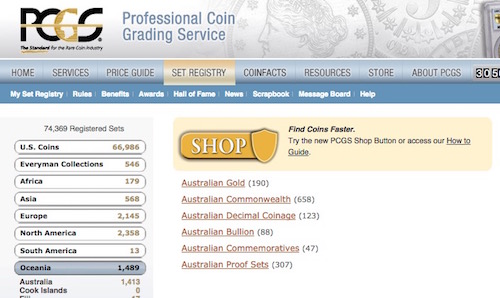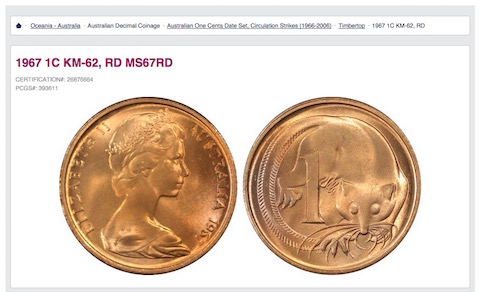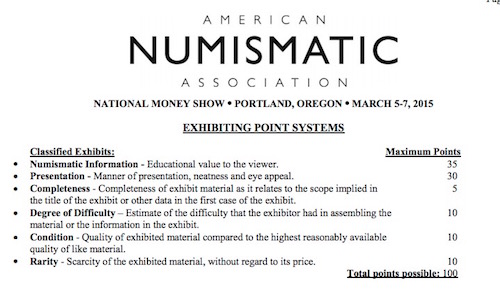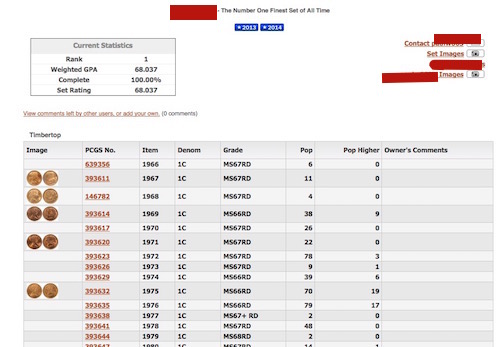The PCGS Registry Set and it's Impact on the Australian Numismatic Market

The Australian numismatic market has been fundamentally affected in the past two years or so by the advent of the PCGS registry set.
This new factor in the market has fundamentally altered the way many Australian coin collectors build their collections, and may well have permanently changed coin collecting in Australia.
This article explores just what a registry set is, why it has changed the way collectors build their collections, and what they mean for collectors and vendors in the Australian rare coin market.
So What Is a Registry Set?
PCGS describes the registry set as “...a powerful inventory management tool built for coin collectors of all levels.”
There are a number of aspects to a registry set, some of them are quite complex. What follows is an earnest attempt to cover off the key points as clearly as possible:
A registry set is an online record of a set of coins that have been independently graded.
The details of each coin in the set have been registered with the company that independently graded the coins.
The public record for each coin within a set displays identifying information about the coin, information such as the coins’s certificate number, it's grade, several statistics relating to the graded population of that coin, and a field for comments by the owner. Digital images are generally shown for the coin also.

The private record for each coin within a set can also include the coin’s cost, the date of purchase, as well as where the coin was purchased from.
Only coins that have been graded by the grading company can be included in their registry sets.
Once a set has been registered, the extent of completion, as well as the quality and rarity of each of the coins in a registry set has now been empirically measured - to two decimal places no less.

This numerical measurement of a collection means a registry can be directly compared to similar sets formed by other collectors, and enables the owner “to compete for awards and recognition”.
It’s this final sentence that explains why registry sets have fundamentally changed how many collectors now build their collections. It sounds fairly innocuous, however it is an incredibly important change.
"To Compete for Awards and Recognition"
It would be completely absurd to assert, even for a second, that prior to the advent of the registry set, coin collectors didn’t compete for rewards and recognition.
Collectors have fought each other for the right to own prized coins for as long as coins have been made - 2,500 years at the very least. Some of the rewards of numismatics come from using intelligence, strategy or audacity to outwit fellow collectors to secure an item for a collection.
Collectors from all walks of life have long shared their coins with their family, friends, colleagues, fellow collectors and with the world at large.
Further, for many collectors, the social cachet that comes with people knowing that one owns an important or valuable item is just as important as owning the item or collection itself!
Some of the most famous coin collections ever formed are celebrated because the collectors that formed them were driven and determined to build a collection that would be celebrated by others for it’s quality, rarity or history.
The desire by a collector for recognition has long been seen in a packed auction room, when a buyer exhibits pride, satisfaction and pleasure in securing a hard-fought auction lot. The reward is owning the lot, the recognition comes from everyone knowing who bought it!
Outside the auction room and away from the bourse floor, competitive numismatics in the traditional sense has been quite a different activity altogether.
Old School Competitive Numismatics - the Exhibition
Prior to the advent of the registry set, if numismatists ever competed against each other for recognition, it was via a numismatic exhibition. Numismatic exhibits are often held in conjunction with a coin or note show, whereby a range of collectors prepare exhibits that display their collections, and show the history behind them.
Awards for the best numismatic display at an exhibition are generally judged based on factors such as the originality of the theme, the quality of the numismatic information displayed, the attractiveness of the display, as well as the degree of difficulty involved in building it.
Awards for a numismatic exhibition are generally judged by a panel of experts, which in itself can be a confronting and challenging process.

While many collectors might like to display their collections to those interested in viewing them, many would have been put off by the logistics involved. Preparing a successful numismatic display involves no small amount of effort, can pose a security risk to the items being exhibited (and the owner), is restricted to being seen at a specific time and place, and can obviously quite public.
Although collectors have quite clearly competed for recognition and rewards for thousands of years, there can be no doubt that a registry set enables collectors to exhibit their collections in a far more immediate and compelling way than they have ever been able to before.
An Online Registry Set - Immediate and Compelling
The process of setting up a registry set is fairly simple - a collector will:
- Set up an account with one of the large independent coin grading companies such as PCGS or NGC;
- Choose the set that they wish to register from the list of sets available; and finally
- Add the certificate numbers for the coins that they own to that set.
The total time taken to “register” a set is dependent on the number of coins in the set being built - it’s all pretty much a point and click process, and is quite painless.
The thing about building a registry set is that the comparative information on the set is updated in real time as each new coin is added to the set.
As soon as a collector has finished adding all their coins to their registry set, they can see how it ranks against all other comparable sets being built, what the average grade of each coin in their set is, and the percentage of the set they’ve built to date.

The real innovation of the registry set is that the feedback loop to the collector once the data has been entered is incredibly short - the collector gets to see the results immediately.
The impact this has on buying decisions is incredibly powerful - once a rank, grade or rating changes, the wisdom of a purchase is affirmed straight away. Acquisitions that don’t add as much to a set’s score as the collector would like also provide feedback - it underlines exactly the type of coin that should have been bought with an increasing rank in mind!
With this immediate feedback loop in place, no sooner does a collector see the score of their registry set change, they’re already planning their next purchase.
That is what makes the registry set such a "powerful collection management tool", and a factor in the marketplace that active collectors and vendors need to appreciate, even if they aren’t building registry sets themselves!
I’m convinced it’s that short and powerful positive feedback loop that has caused the prices of condition rarity coins to rise so strongly in years past. The mental preparation that leads to determined bidding on the finest known coins with a laser-like focus really begins with a stark assessment of a registry set, and furthermore, what’s required to push it ahead even further.
Original Surfaces Get You In The Door
In the “olden days" before independent grading took a sizeable hold of the Australian numismatic market (and we’re going to have to coin a new acronym that describes the two different eras - the days before independent grading and the time since!), the vast majority of collectors bought coins in a series within a grade range they were comfortable with. Depending on the series being discussed and a collector’s budget, that grade range mint be Uncirculated or better, it might have been between Very Fine and Extremely Fine, it might have been about Unc.
If a coin was attractive to the eye and was affordable for the advertised grade, it generally passed muster and a collector was proud to own it. While some collectors and dealers might have turned away from a coin that’d been dipped, cleaned or had an odd tone, in my observation they certainly weren’t in the majority. If a coin was an attractive mint-state example and it had minor hairlines across one side or bag marks in the fields, it was still widely regarded as being an acceptable coin.
Today's collector however (that is, a collector that has only ever bought and sold coins in an environment where pretty much all coins have been independently graded) comes to learn pretty quickly that only coins with original surfaces (both for tone and contact marks) will be independently graded, and therefore only coins with original surfaces qualify to be added to their registry set.
The question of whether a rare, historic and attractive coin is worth owning if it can’t be added to a registry set is one that'll be answered by most collectors (in the negative) pretty damn quickly, however it is probably worthy of being used as a Buddhist kōan - “...a nonsensical or paradoxical question for which an answer is demanded, the stress of meditation on the question often being illuminating.”
I'll set aside meditating on that question for another day, and will observe that the past few years has seen the market drop markedly for coins that no longer have original surfaces. Whether these coins were quite popular, accepted without question and were even keenly contested for by collectors in years past is not of any interest at all to today’s collector. If a coin can’t get independently graded these days, it won’t even be considered by many collectors today, regardless of it’s provenance, eye appeal or past desirability. Unless a coin has original surfaces, it won’t even be considered for grading, much less added to a registry set.
Make no mistake, many collectors are now better off that coins that have been cleaned, artificially toned or impaired in some other way are not widely traded on the open market. Many a collector has been unwittingly caught out in years past by buying a problem coin that was spurned by collectors or fellow dealers when the time came to sell it.
There Is Now An Overriding Emphasis on Quality
Not only do the majority of collectors these days insist only on coins with original surfaces, they are now more focused on quality than they ever have been.
It isn’t a new thing for collectors to aspire to owning coins in the best possible condition, collectors have almost been hard-wired to find historic items in premium condition since the dawn of time! A rare or even a common coin in superlative condition has always been compelling to collectors, and this is precisely why independent grading came about.
That said, I believe it’s fair to say that more collectors today use quality as a key determinant in choosing which series they collect, as well as which coins they collect.
I’ve met more than a few collectors that have chosen to be active in a certain series of coins simply because that is the series their budget permits them to buy "condition rarities” in. A collector might have more interest in perhaps an old series of coins, however as they can’t afford to buy the finest condition examples in that series, they set their sights in a different area because it’s affordable.
The old line from that old Crosby Stills and Nash song comes to mind - “If you can't be with the one you love, love the one you're with.” Now that many, many collectors choose to focus not only on coins in premium condition, but also on sets that include coins that are affordable in premium condition, it has played a very significant role in determining not only which coins bring the strongest prices, but also which series are active and which ones are not.
In years past, it was standard practice for many collectors to buy “key date” coins in mid grade, sometimes even accumulating quantities of them. Now that the registry set is a function of the numismatic landscape, collectors that might have followed that path in previous years now prefer to purchase "common date” coins in premium or even superlative condition.
What This Means for Collectors and Vendors Today
After taking in this appraisal of the market, I hope that the consequences of the registry set to collectors and vendors today is patently clear:
Coins that do not have original surfaces no longer have the appeal they used to - this is a trend that I expect will become more apparent as time passes. Anyone that is buying coins now really needs to be keenly aware that “raw” coins (that is, those coins that haven’t yet been independently graded) that don’t have original surfaces are very difficult to sell at a price close to what such coins commanded in years past. If you own a coin that doesn’t have original surfaces, you may be best served by cutting your losses sooner rather than later - I don’t see any changes in the market that will cause demand to increase for such coins in the medium term at least!
If you sell a coin today that you think is in premium condition and you don’t get it independently graded, you’re almost certainly leaving money on the table. I have no doubt there will be more than a few old-school collectors reading this article who have a great deal of disdain for independent grading, slabs and the collectors that buy them. They will no doubt say any collector that consistently pays a premium for top graded coins is crazy, and further that they’ll have no part in it.
I would be extremely surprised however if such collectors don’t get their coins graded before offering them for sale, not with the stratospheric prices currently being paid for coins in premium condition. The simple truth is, if you sell a coin today that you think is in premium condition and you don’t get it independently graded, you’re almost certainly leaving money on the table, perhaps thousands, if not tens of thousands of dollars.
The registry set has caused collectors to focus on quality more than they have at any time in the history of the Australian numismatic market. It has also caused demand to drop off significantly for coins that don’t have original surfaces.
Postscript:
I’ve written this article to explain the role that the registry set plays in the market to collectors that may not have fully understood it in the past. I’d love to hear if you have any questions at all about the points raised. If you think that some of the points I’ve made here are inaccurate or need to be corrected, please use the comments field below to let me know.
